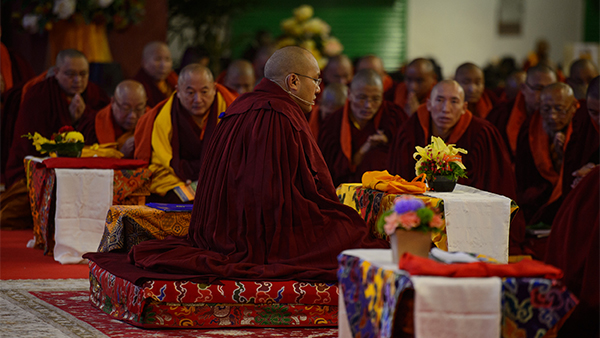January 11, 2014
Monlam Pavilion, Bodhgaya
Arriving at the centre
In the pitch black of the early morning, as lines of people make their way to Tergar Monastery, a rare winter rain falls steadily over Bodhgaya. Arriving from all directions they converge at the centre of the Gyalwang Karmapa’s vast mandala, the Monlam Pavilion, where his Buddha activities are about to commence.
The wet, muddy paths mean the usual long queues are fast-tracked, and people pass relatively quickly down the slippery driveway. They enter through the Monlam welcome gate, adorned with fluttering prayer flags and rows of fairy lights glowing in the early morning darkness.
Inside the vast pavilion, clouds of fragrant incense permeate the space as the neatly laid out mats gradually fill with people. Rows of monks and nuns, heads freshly shaven, sit wrapped in their warm winter dagam cloaks, while lay people bundle up in thick coats and blankets to ward off the pre-dawn chill.
At 6am the sound of gyalings pierces the darkness and all stand to welcome the Gyalwang Karmapa into the Pavilion. He offers three prostrations to the golden Buddha at the apex of the stage and sits, facing the 9000 people gathered before him.
The first opening verses of the refuge prayer resound throughout the pavilion, signaling a start to the 31st Kagyu Monlam Chenmo.
Sanskrit: A bridge back to the Buddha
As the Sojong ritual ends, the umze or chantmaster next begins the Sanskrit prayers – Refuge, the Sutra of the Recollection of the Three Jewels, and the Heart Sutra.
The unique power of blessings within the Sanskrit syllables, accumulated through 2500 years of recitation, is tangible. With a particular ability to move the minds of those who hear and recite them, the Sanskrit prayers invoke the blessings of a Buddhist dharma that goes far beyond its present manifestation, back to the time of the Buddha Shakyamuni himself.
It was the Gyalwang Karmapa’s wish some years ago to reintroduce Sanskrit prayers into the Monlam, and the Kagyu lineage, in homage to the Indian roots of Buddhism. This daily recitation of Sanskrit prayers has become a hallmark of the Kagyu Monlam, leaving deep imprints in the minds of those who hear and recite them, and reawakening ancient karmic connections with the Buddha dharma.
The right place
This year people from over 30 countries have gathered together, in the sacred place of Bodhgaya, to unite in aspirations for peace in the world.
“Many different ethnic groups and different languages from all over the world have gathered for the sake of peace,” the Gyalwang Karmapa tells those gathered. “We’ve come here with the same wishes and intentions, and the power of positive aspirations is magnified when performed together, with a single intention, by many people.”
He then observes the unseasonal rain, and the extra difficulties this has posed to people in arriving.
“This has made me think very much of how fortunate we are to have been able to create this pavilion,” the Gyalwang Karmapa explains, “because without it I don’t see how we would be able to convene given the weather—and who knows whether it will continue. So I think we’ve done very well indeed to be able to create this pavilion for the Monlam.”
A rain of praises
As the day progresses the prayers flow smoothly, one into another, in an interrupted stream of aspiration and praise.
In a rare treat for those gathered, the Gyalwang Karmapa remains on stage the entire day, leading all four sessions on the first day of the Monlam.
The rain continues falling throughout the day, drumming on the pavilion roof, sometimes softer, sometimes louder, like a heartbeat to the Monlam taking place below.
And as the rain continues outside, it becomes merely an external reflection of the rain of prayers and praises falling continuously inside.



